The Delicate Art of Flourless Chocolate Cake
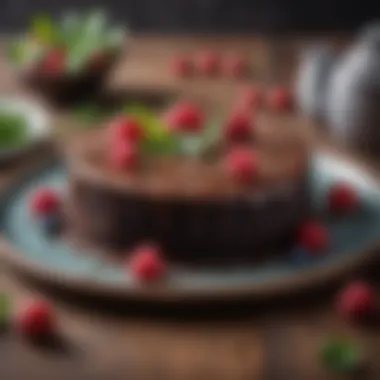
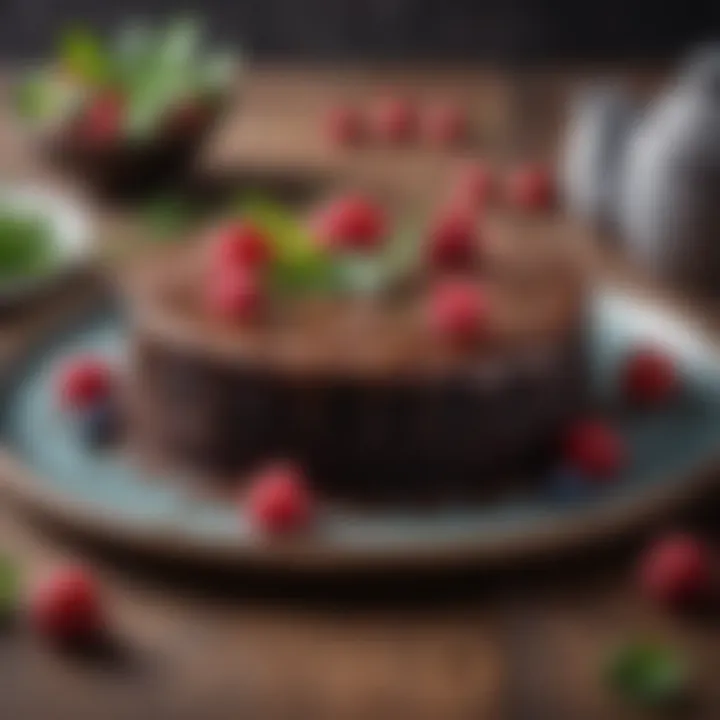
Intro
Flourless chocolate cake has gained distinct relevance, particularly during Passover. This cake is not just a dessert; it embodies tradition and offers a deliciously rich option that aligns with Jewish dietary laws. With the absence of flour, it caters to those who observe gluten-free diets while providing an indulgent experience that can satisfy a range of palates.
The history of flourless chocolate cake can be traced back to Europe, where it emerged as a delightful dessert favored for its deep chocolate flavor and simplicity. Understanding its historical significance adds depth to its preparation and enjoyment, making it more than just a recipe; it becomes part of a culinary legacy.
The versatility of a flourless chocolate cake means it can adapt to many preferences and dietary needs. It serves not only as a staple for Passover but also finds its way onto tables year-round. This cake has captivated food enthusiasts, appealing to both novice and experienced cooks.
In this article, we will explore various aspects:
- The essential ingredients needed for a perfect cake.
- Detailed preparation methods that highlight the intricacies of the baking process.
- Creative variations to suit changing dietary guidelines and preferences.
- Tips for presenting this sophisticated dessert to elevate any occasion.
This guide aims to provide comprehensive insights and understanding of how to create a flourless chocolate cake that resonates with tradition and flavor, ensuring that it remains a cherished part of Passover festivities.
Historical Context of Flourless Chocolate Cake During Passover
Flourless chocolate cake has gained a prominent role in contemporary Passover celebrations, reflecting not just culinary trends but also broader cultural narratives within Jewish traditions. This cake, rich in flavor and devoid of any flour, aligns seamlessly with dietary restrictions during Passover. The significance of this dessert goes beyond taste; it embodies a blend of tradition, modern adaptation, and dietary observance.
Origins of Passover Dietary Practices
Passover, or Pesach, commemorates the liberation of the Israelites from Egyptian slavery. During this period, the consumption of chametz, which includes all leavened bread, is strictly forbidden. The rationale is rooted in the historical narrative of a hasty exodus where there was no time for bread to rise. Such dietary constraints have propelled the search for alternatives that comply with Jewish law while still delivering satisfying flavors.
In this context, the flourless chocolate cake emerges as a modern innovation that respects the ancient rules while offering a delectable option for dessert. Before the rise of flourless confections, traditional Passover desserts were often based on matzo meal or nut flour. This practice, while honoring dietary laws, did not always yield the rich textures and flavors associated with standard baked goods. The shift to flourless recipes, such as the chocolate cake, allows for superior taste without compromising kosher practices.
Traditional Passover Desserts
Historically, Passover desserts featured a variety of options like macaroons or sponge cakes infused with matzo meal. While these treats have their charm, they often lack the depth that a flourless chocolate cake provides. The transition to flourless varieties represents a significant cultural shift, emphasizing the willingness to embrace new ingredients and methods.
Flourless chocolate cake has become particularly favored not only for its indulgent texture but also for its ability to cater to diverse dietary needs without sacrificing flavor. Many bakers appreciate that flourless chocolate cake can be enjoyed by gluten-sensitive individuals, making it a versatile choice for gatherings that include diverse guests.
This progression over time—from matzo meal-based desserts to flourless creations—underscores a key theme: the potential for culinary evolution within the framework of traditional practices. It is a testament to the adaptability of Jewish cuisine, reflecting a balance of respect for the past and innovation for the future.
To summarize, the historical context of flourless chocolate cake during Passover highlights how changing dietary practices have shaped dessert options. The cake not only aligns with the dietary laws but also offers a rich, modern alternative to time-honored traditions, resonating with both food lovers and those observing the holiday.
Understanding the Ingredients
Understanding the ingredients is fundamental in creating an exceptional flourless chocolate cake. Each component not only contributes to the distinct flavor and texture but also plays a vital role in achieving the right balance. As flourless chocolate cake has gained recognition in various culinary circles, mastering the selection and use of its key ingredients becomes essential for both novice bakers and seasoned chefs alike.
Selecting Quality Chocolate
Choosing high-quality chocolate is perhaps the most critical step in this recipe. The chocolate can dictate the cake’s richness and overall flavor. Opting for a dark chocolate with at least 70% cocoa can provide deep, intense flavors. Additionally, premium brands such as Callebaut or Valrhona offer products without additives, ensuring a pure chocolate taste. When selecting chocolate, look for limited ingredients. Avoid brands that include fillers or unnecessary preservatives.
Furthermore, consider the cocoa origin. Different regions produce chocolates with unique flavor profiles. A single-origin chocolate can infuse distinct notes into the cake, elevating it from simple dessert to a gourmet experience. When melting chocolate, do so gently to maintain its texture. Overheating can lead to a grainy texture and diminished flavor.
Role of Eggs in the Recipe
Eggs serve multiple purposes in a flourless chocolate cake. They provide structure, moisture, and richness. The type of egg you use can also affect the final outcome. Fresh, high-quality eggs tend to yield better results compared to cheaper alternatives.


When using eggs, the process of whipping them properly is crucial. This technique allows air to be incorporated, giving the cake a light, airy texture. Typically, both whole eggs and egg whites are used. The addition of whipped egg whites creates a soufflé-like quality, helping the cake rise and maintain a desirable consistency once baked. Pay attention to achieving the correct peaks when beating the egg whites. The right peak will contribute to both texture and volume, enhancing the overall experience of your flourless chocolate cake.
Sweeteners and Alternatives
Choosing the right sweetener can enhance or detract from the cake's flavor. Traditional granulated sugar is common, but alternatives like coconut sugar or honey can also be used. Each sweetener brings unique characteristics and flavors. For example, sugar gives pure sweetness without altering texture, while honey introduces a slight floral note.
For health-conscious bakers, sugar substitutes like erythritol or monk fruit can be appealing. Be mindful of their sweetness levels, as some are more concentrated than sugar. Experimenting with these alternatives can yield surprising flavors and textures. Ultimately, it's about finding a balance between flavor and preferred dietary needs. The sweetener should complement the chocolate, allowing its flavor to shine through.
"The choice of ingredients directly affects the cake’s flavor profile and texture, making it essential to select wisely."
Mastering the understanding of these ingredients ensures that the flourless chocolate cake is not just a dessert but an indulgent showcasing of chocolate’s capability. Prioritize quality and balance to create a refined and delightful experience.
Preparation Techniques for Flourless Chocolate Cake
Preparation techniques play a pivotal role in the successful creation of a flourless chocolate cake. This dessert relies heavily on precise methods, as the absence of flour magnifies the importance of each ingredient and step involved. Achieving the right texture and taste can be a challenge, making these techniques essential. Understanding the fundamental processes ensures a rich, decadent outcome that aligns with the expectations of any festive gathering, especially during Passover. Each technique contributes not only to the end product but also to the experience of baking, offering a chance to connect with the tradition of this time-honored dessert.
Melting Chocolate Properly
Melting chocolate properly is a critical first step in preparing a flourless chocolate cake. The goal is to achieve a smooth and velvety texture that can blend seamlessly with other ingredients. There are different methods to achieve this, specifically using a double boiler or a microwave. The double boiler method involves gently heating water in a pot and placing a heat-proof bowl on top, ensuring that the chocolate does not come into direct contact with the heat source. This method allows for gradual melting, minimizing the risk of scorching.
Alternatively, the microwave method can be quicker but requires vigilance. Chocolate can burn easily in a microwave, so it's important to melt it in short increments, stirring in between. This allows for even heating and reduces the chance of the chocolate overheating. The consistency of the melted chocolate is crucial; it should be silky and glossy without any lumps. This careful approach to melting chocolate ensures that the flavor remains pure and bold, setting the stage for the overall richness of the cake.
Whipping Egg Whites
Whipping egg whites is another vital technique in this preparation. Egg whites create the lightness and airy texture that distinguishes flourless chocolate cake from other kinds. For this to be effective, it is essential to use fresh eggs and a clean bowl. Even a small amount of fat from the bowl or whisk can prevent the egg whites from whipping properly. Start by ensuring all equipment is dry and clean.
The beating process should begin at a low speed and gradually increase. Once soft yet stable peaks form, focus on not overwhipping, as this can lead to a dry texture. The egg whites should eventually be folded into the chocolate mixture carefully. This folding technique is critical because it listens to the structure created by the whipped egg whites, which allows the cake to rise during baking without compromising the overall integrity of the batter. Proper techniques in this step are crucial for achieving the desired texture and moisture in the final product.
Combining Ingredients Effectively
Combining the ingredients effectively is the final technique that ties the previous steps together. After melting the chocolate and whipping the egg whites, it is important to maintain the integrity of the batter. Begin by adding a small portion of the egg whites into the chocolate mixture. This step lightens the chocolate, making it easier to fold in the remaining egg whites.
Use a spatula to fold gently, ensuring that the chocolate can incorporate the egg whites without deflating them. The key is to be gentle here; vigorous mixing can lead to a dense cake. It’s best to work in a figure-eight motion, which helps to combine without losing volume. The end result should be a cohesive, smooth batter that holds its shape yet remains airy.
Proper preparation techniques transform simple ingredients into a sophisticated dessert that holds its own for any occasion, particularly during Passover.
The techniques of melting chocolate, whipping egg whites, and combining the batter are all integral to creating a flourless chocolate cake. Mastering these methods ensures that the cake is both flavorful and has the right texture, allowing it to shine on any holiday table.
Alternative Dietary Considerations
In today's culinary landscape, accommodating diverse dietary needs is essential. This is particularly true during Passover, where traditional dietary laws coalesce with modern health considerations. The significance of alternative dietary considerations in this context cannot be overstated. As more people adopt vegan, sugar-free, or healthier eating habits, flourless chocolate cake may adapt to meet these needs without sacrificing flavor or texture. Recognizing this, we delve into three specific adaptations that ensure this dessert remains inclusive and enjoyable for all.
Vegan Flourless Chocolate Cake
For those adhering to a vegan lifestyle, creating a flourless chocolate cake involves substituting traditional ingredients like eggs and dairy. This may seem challenging initially, but there are many effective alternatives.
- Egg Replacers: Common substitutes include ground flaxseed mixed with water or applesauce. Both options provide binding properties necessary for structure.
- Plant-Based Chocolate: Ensure that the chocolate used is dairy-free, as many brands offer options specifically for vegans. Brands like Enjoy Life or Hu Chocolate are often good choices.
- Nut Butters or Coconut Oil: These can be used to add richness and moisture. They enhance the texture without compromising the cake’s delightful chocolate flavor.
The finished cake possesses a rich taste that aligns beautifully with traditional flavors, celebrating the spirit of Passover while respecting dietary choices.
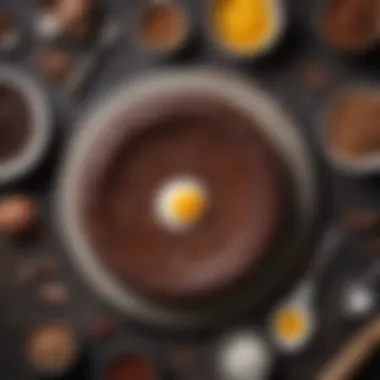
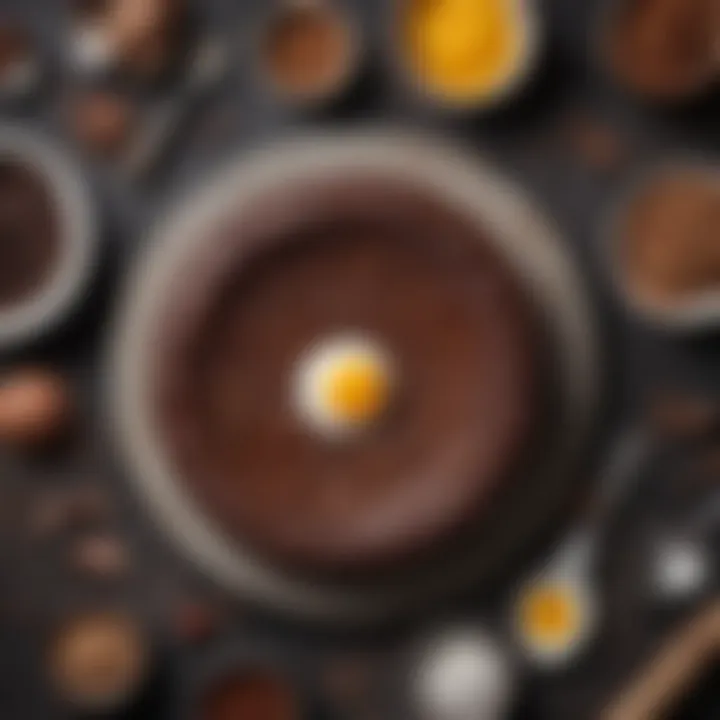
Sugar-Free Variations
As the concern for sugar intake rises, sugar-free flourless chocolate cake has garnered interest. This variation primarily employs low-calorie sweeteners, allowing enjoyment without the sugar rush.
- Natural Sweeteners: Options like stevia, erythritol, or xylitol can replace refined sugars. Each has unique properties and sweetness levels, so experimentation may be necessary to find the right fit for taste preferences.
- Aging Chocolate: High-quality, bitter dark chocolate often contains less sugar than regular chocolate, contributing to a more decadent flavor profile.
- Adjusting Other Ingredients: Monitor the balance of ingredients when using sweeteners to prevent altering the cake's structure.
Offering a rich, satisfying taste while loosening sugar constraints, a sugar-free flourless chocolate cake is a valuable addition to one’s repertoire during Passover.
Incorporating Healthy Fats
Incorporating healthier fats into a flourless chocolate cake recipe can enhance nutritional value without sacrificing indulgence. Exploring healthy fat options is beneficial for various dietary preferences and can significantly impact the overall cake quality.
- Avocado: Often overlooked, ripe avocados provide a creamy texture and a wealth of nutrients, including healthy mono-unsaturated fats. Pureed avocado can be used in place of some fats for a subtle flavor.
- Nut Oils: Using oils from nuts, such as almond or walnut oil, adds not only fat but also flavor complexity to the cake. They offer omega-3 fatty acids, which are beneficial for heart health.
- Coconut Oil: This popular choice is rich in medium-chain triglycerides (MCTs), which are known for their health benefits. It adds a slight coconut flavor that pairs exquisitely with chocolate.
When done thoughtfully, these healthy fat adaptations create a flourless chocolate cake that delights the palate while aligning with contemporary health consciousness.
"By exploring alternative dietary considerations, we ensure the flourless chocolate cake remains a dessert that welcomes all households, celebrating diversity without compromising tradition."
Baking and Serving Suggestions
Baking and serving suggestions play a crucial role in elevating the experience of a flourless chocolate cake, especially during Passover. The careful selection of baking conditions contributes to the overall texture and flavor of the cake. In addition, thoughtful serving methods enhance the presentation and enjoyment of this dessert. By understanding these aspects, you can ensure that your cake not only meets dietary standards but also delights guests at any gathering.
Optimal Baking Conditions
To attain the ideal texture and moisture levels, several factors must be considered when baking a flourless chocolate cake. The temperature of the oven is one critical element; it should typically be set at 350°F (175°C). Consistent heat ensures even baking while preventing the cake from becoming dry. It is advisable to place the cake on a middle rack in the oven to allow for optimal air circulation.
Another important consideration is the baking time. Generally, this type of cake requires about 20 to 25 minutes of baking. However, each oven may vary, so keeping an eye on the cake as it approaches the end of the baking time is wise. A slight underbake can leave the center fudgy, which is often desired. Using a toothpick to test for doneness can be effective, as it should come out with a few moist crumbs attached.
Cooling and Storing the Cake
After baking, the cooling process is equally significant. Once removed from the oven, the cake should be allowed to cool in the pan for approximately 10 to 15 minutes. This helps it to set and reduces the risk of breaking when transferred. After this initial cooling, carefully invert the cake onto a wire rack to cool completely.
Storing the cake is also essential for maintaining freshness. Wrapped tightly in plastic wrap or stored in an airtight container, a flourless chocolate cake can last for about three to four days at room temperature. For longer storage, refrigerating it extends its life to about a week. Freezing the cake is another option for preserving it for several months. Slice it before freezing to make serving easier later on.
Presentation Techniques
The presentation of a flourless chocolate cake can greatly enhance its appeal. A simple yet elegant approach involves dusting the top with powdered sugar or cocoa powder just before serving. This not only adds visual contrast but also offers a touch of sweetness.
Garnishing the cake with fresh berries or a dollop of whipped cream can provide delightful flavors that complement the rich chocolate. Alternatively, creating a chocolate ganache to pour on top can add a glossy finish and enhance the overall experience.
For a more sophisticated aesthetic, consider serving slices on individual plates, accompanied by sauces like raspberry coulis or a drizzle of caramel. A few mint leaves can serve as a fresh garnish.
Above all, consider the occasion and audience when choosing how to serve the cake. Thoughtful presentation not only pleases the eye but also honors the tradition behind the dessert.
"A well-presented cake is not just a dessert; it is an experience that guests will remember."
Culinary Pairings with Flourless Chocolate Cake
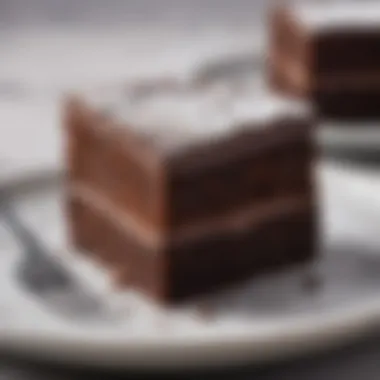
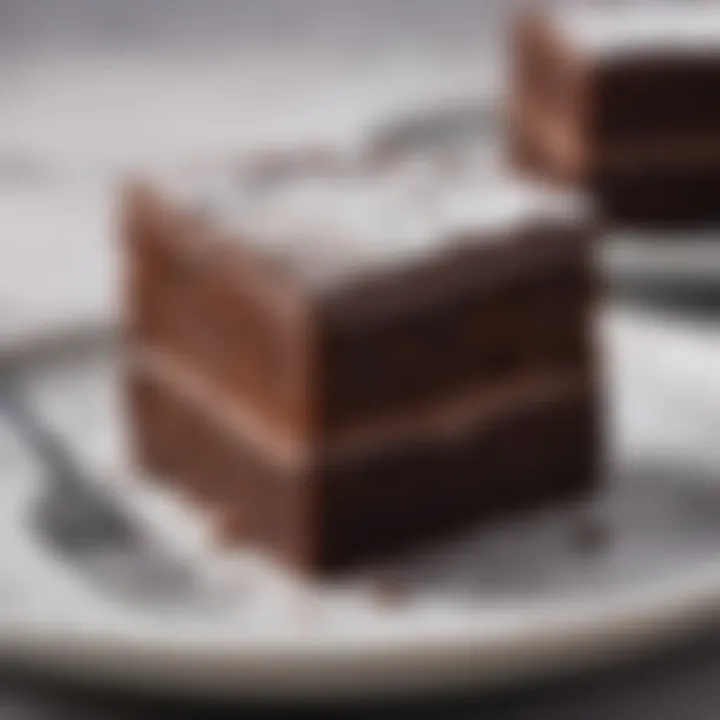
Culinary pairings are essential when it come to enjoying a flourless chocolate cake for Passover. The right combinations can elevate the canvas of rich chocolate flavors, creating a more complex and enjoyable dessert experience. This section focuses on two critical aspects: wine pairings and complementary sides. By understanding what works well alongside your cake, you can enhance not only the flavors but the overall presentation and enjoyment of the dish.
Wine and Dessert Pairings
Choosing a suitable wine to pair with flourless chocolate cake is important. The robust chocolate flavor demands a wine that can stand up to its intensity. Here are important considerations:
- Red Wines: Full-bodied red wines such as Cabernet Sauvignon or a Merlot can enhance the dark chocolate notes in the cake. These wines often have their own fruity or spicy undertones, contributing complexity to each bite.
- Port: A tawny or ruby port presents a rich sweetness that complements the cake's texture, making it a favorite for many dessert pairings.
- Sparkling Wines: On the other hand, a dry sparkling wine can provide a contrast. The bubbles cleanse the palate after each bite, renewing the taste experience.
When selecting a wine, consider the sweetness and richness level of the flourless chocolate cake. The balance between wine and dessert is crucial, often enhancing individual flavors.
"Pairing is about making choices that work together harmoniously. Be mindful of the chocolate and the wine's highlights."
Complementary Sides and Sauces
Besides wine, complementary sides and sauces can intensify the taste of the flourless chocolate cake. The following elements can be effectively paired:
- Whipped Cream: A simple but classic choice, whipped cream adds a light texture and a sweet contrast. Consider flavoring it with vanilla or even a touch of espresso.
- Fresh Berries: Berries such as raspberries or strawberries add a pop of freshness. Their natural tartness contrasts beautifully with the richness of the cake.
- Chocolate Sauce: For chocolate lovers, drizzling extra chocolate sauce can amplify the dessert experience. It provides a luxurious touch and is easy to make.
- Ice Cream: A scoop of vanilla or coffee ice cream can create a delightful mix of temperatures and textures that enhances the indulgence.
When designing your dessert plate, think about the visual aspects as well. A well-arranged plate with sides can make a simple cake appear more elegant and inviting. Together, the sides and sauces harmonize with the cake, providing a fuller and more satisfying experience.
Cultural Significance of Flourless Chocolate Cake
Understanding the cultural significance of flourless chocolate cake during Passover enhances appreciation for this dessert beyond its taste. This cake embodies both tradition and modernity in Jewish culinary practices. It reflects the adaptation of recipes that cater to dietary restrictions mandated during Passover, while still enticing to a wide audience.
Modern Adaptations in Jewish Cuisine
Flourless chocolate cake showcases the evolving nature of Jewish cuisine. As Jewish communities have spread across the globe, they have incorporated local flavors and ingredients, reshaping traditional dishes. The flourless chocolate cake is a prime example. It adapts to the need for gluten-free options while still remaining a celebratory dish for Passover.
This flexibility has allowed it to become a household favorite that resonates with both Jewish and non-Jewish audiences.
Ingredients like almond meal, cocoa powder, and high-quality chocolate offer alternatives to traditional flour-based confections. This adaptation is not just about food; it represents a cultural melding that maintains Jewish identity while inviting broader acceptance.
Flourless Cake Beyond Passover
The significance of flourless chocolate cake transcends the Passover holiday. In recent years, this dessert has become popular year-round, appearing in various settings from casual family gatherings to upscale restaurants. Its rich taste and elegant presentation make it suitable for any occasion.
Additionally, the rise of gluten-free diets has propelled this cake into the mainstream culinary scene. People with gluten sensitivities are finding solace in a dessert that doesn't compromise on flavor. Flourless chocolate cake is now a staple in bakeries and homes alike, bridging cultures and dietary preferences.
Concluding Thoughts
The elements surrounding the creation of a flourless chocolate cake for Passover encompass not only culinary techniques but also a deep respect for tradition. Understanding this dessert’s historical context, its essential ingredients, and the various preparation methods can significantly elevate one's culinary experience during the holiday.
By focusing on both tradition and innovation, cooks can celebrate Passover in a meaningful way. This cake serves as a bridge connecting generations and cultures. Whether it is the rich, intense flavor of high-quality chocolate or the meticulous preparation of eggs and sweeteners, each step in the process lends a layer of significance to the final product.
Embracing Tradition and Innovation
The balance between traditional practices and contemporary adaptations is vital in the kitchen. Embracing tradition involves recognizing the historical significance of the flourless cake within Jewish culinary heritage. Passover is a time when dietary restrictions are observed. This cake respects those laws while allowing room for innovation.
Many bakers now explore alternatives, adding unique flavors or using healthier options for sweeteners, such as agave or maple syrup. This opens the door for a diverse audience while maintaining the cake's essence. Furthermore, vegan adaptations provide an inclusive approach, inviting those with different dietary preferences to partake in this culinary delight.
The beauty of this cake lies in its versatility, making it not just a Passover treat but a dessert that can be enjoyed year-round. Thus, the journey of creating a flourless chocolate cake not only adheres to tradition but also embraces modern culinary trends, appealing to food lovers of all ages.
"Cooking is an act of love, including love for our dietary restrictions and innovative culinary expressions."
Ultimately, the flourless chocolate cake exemplifies how tradition can evolve without losing its core. This flexibility allows family gatherings and festive occasions to become more than just meals; they turn into experiences that foster connection and appreciation for both the past and the present.







